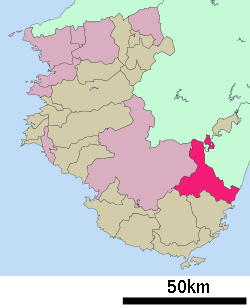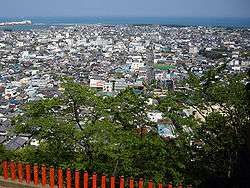Shingū, Wakayama
| Shingū 新宮市 | ||
|---|---|---|
| City | ||
|
Skyline of Shingū viewed from Kamikura Shrine | ||
| ||
 Location of Shingū in Wakayama Prefecture | ||
 Shingū Location in Japan | ||
| Coordinates: 33°43′N 136°0′E / 33.717°N 136.000°ECoordinates: 33°43′N 136°0′E / 33.717°N 136.000°E | ||
| Country | Japan | |
| Region | Kansai | |
| Prefecture | Wakayama Prefecture | |
| Government | ||
| • Mayor | Michitoshi Taoka (since November 2009) | |
| Area | ||
| • Total | 255.43 km2 (98.62 sq mi) | |
| Population (May 1, 2011) | ||
| • Total | 32,288 | |
| • Density | 130/km2 (330/sq mi) | |
| Symbols | ||
| • Tree | Nageia nagi, Kumano sugi, Tendaiuyaku (Lindera strychnifolia) | |
| • Flower | Crinum asiaticum and Kawasatsuki | |
| Time zone | Japan Standard Time (UTC+9) | |
| City hall address |
1-1 Kasuga, Shingū-shi, Wakayama-ken 647-8555 | |
| Website |
www | |
Shingū (新宮市 Shingū-shi) is a city located in Wakayama Prefecture, Japan. The city was founded on October 1, 1933.
As of May 1, 2011, the city has an estimated population of 32,288, with 16,003 households and a population density of 126.41 persons per km². The total area is 255.43 km2 (98.62 sq mi).
Shingū literally means 'New Shrine' and refers to Hayatama Shrine, one of the Three Grand Shrines of Kumano (See[1]). The 'old shrine' would be Kamikura Shrine.
Shingū is the central commercial city of the Kumano Region in Japan where Shingū Station is situated, and is one of the largest cities in Wakayama Prefecture.
It is a sister city to Santa Cruz, California.[2]
Each Spring, The City of Santa Cruz sends about 14 middle school/ high school delegates to visit Shingū and to interact with the Japanese society.
On October 1, 2005 the town of Kumanogawa (from Higashimuro District) was merged with Shingū.
Sightseeing
Shingū Castle, a.k.a. Tankaku Castle. Only the foundations remain, for during the Meiji Restoration, it was torn down.
For over a thousand years, pilgrims have traveled to the Kumano Region to pray at The Three Sacred Kumano Shrines: Hongu, Hayatama, and Nachi. Hayatama Grand Shrine is located in Northwest corner of the original town. It is believed that the city started being referred to as "Shingū" (literally "new shrine"), when this shrine was first established. Hayatama Grand Shrine predates Japan's earliest written records, the Kojiki, so there is no way to establish the year it was founded. However, excavations have unearthed remains of religious rituals dating back as far as 300 AD.
Kamikura Shrine commands one of the best views of the city, and is said to be where the 12 deities of the Kumano Grand Shrines first descended from the heavens. The object of worship is a great sacred rock called "Gotobiki-iwa".
Kumano River- arguably one of the most beautiful rivers in all of Japan
Aikido- One of the "birthplaces" of Aikido (a martial art). Aikido is widely practiced throughout the Kumano region and in many areas throughout the world.
Cuisine
A main dish is Nare-zushi, a very traditional type of sushi which, centuries ago, was imported from Southeast Asia to China, and from China to Japan. Narezushi was the birth of sushi, and influenced how the Japanese later made their own styles of sushi that most of us know today.
Another common dish is saury. Saury is a type of fish commonly used as Sashimi in this region. Whale and dolphin meat caught in Taiji-cho (13 mi (21 km) away), is also eaten by a small few.
See also
References
External links
 Media related to Shingū, Wakayama at Wikimedia Commons
Media related to Shingū, Wakayama at Wikimedia Commons- Shingū City official website (Japanese)
- Aikido Kumanojuku Website - Shingū, Japan
- http://kumano-shingu.com/

